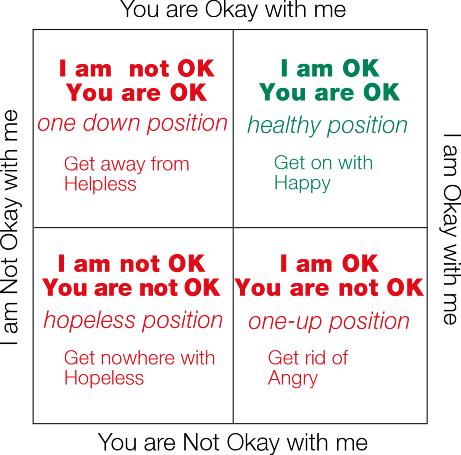Transactional Analysis – life positions
Life positions are basic beliefs about self and others, which are used to justify decisions and behaviour.
When we are conceived we are hopefully at peace, waiting to emerge into the world once we have grown sufficiently to be able to survive in the outside of the womb. If nothing untoward happens we will emerge contented and relaxed. In this case we are likely to perceive the world from the perspective of I am OK and You are OK.
However, perhaps our mother had some traumatic experiences, or the birth was difficult or even life threatening. This experience is likely to have an effect on the way we experience the world, even at the somatic level. In which case we might emerge sensing that life is scary and might, for example, go into “I am not OK and You are not OK either”.
Let’s take it that the pregnancy went fine, and the birth was easy enough. What then? Well life experiences might reinforce our initial somatic level life position, or contradict it. If we were treated punitively, talked down to, and not held, we may begin to believe “I am not OK and You are OK”. This might be the only sense we can make of our experiences.
Let’s take another situation. Perhaps we were picked on and bullied as a child. We learnt that the way to get by was to bully others and that way we felt stronger and in control. Our behaviour then comes into the I am OK and You are not OK quadrant. Of course this may cover up our belief that we are really not OK, but nobody sees that. They just see our behaviour, and in fact we may have forgotten all about our negative feelings about ourselves as we have tried so hard to deny the pain of believing we are not OK.
These life positions are perceptions of the world. The reality is I just am and you just are, therefore how I view myself and others are just that “views” not fact. However, we tend to act as if they are a fact. Just like when somebody says “I can’t do this, I’m useless”. Rather than “I don’t know how to do this. Will you show me?” The latter is staying with the fact that they do not yet know how to do it, whilst the former links being useless with not being able to do something.
There are a number of ways of diagramming the life positions. Franklin Ernst drew the life positions in quadrants, which he called the OK Corral (1971). We have put these into red and green to show the effective and ineffective quadrants for communication and healthy relationships. By shading in the quadrants according to the amount of time we think we spend in each we can get an idea of the amount of time we spend in each. Ernst used the term ‘Corralogram’ for this method of self-assessment using the OK Corral matrix.
the ok corral (franklin ernst, 1971)

Berne talked about the life positions as existential positions, one of which we are more likely to go to under stress. This is significantly different to the concept Ernst uses, i.e. that we move around them all during the day. Whilst there is some truth in this we could agree with Berne that there will be one major position we go into under stress, with perhaps another position underneath this one. These positions can change as we develop and grow. The difference between Berne and Ernst is important.
No Responses • Leave a response


